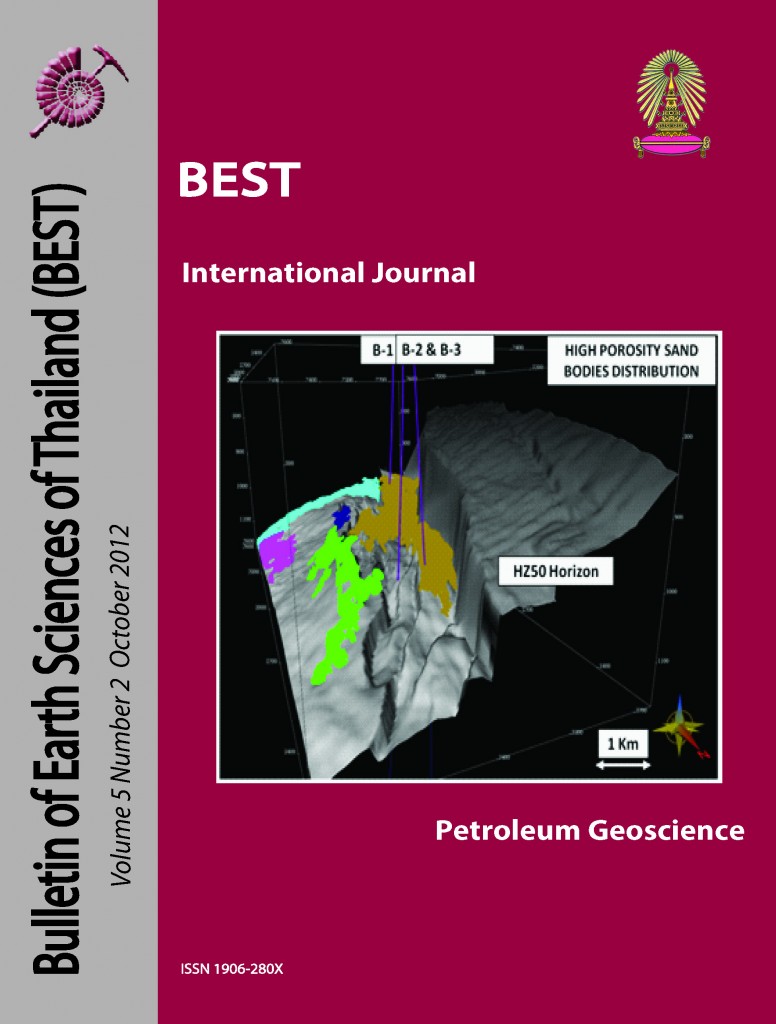Seismic Facies Interpretation of Fluvial/Marginal Marine Sand Architecture in Kra Basin, Gulf of Thailand
Main Article Content
Abstract
The study area lies in the Kra basin, Gulf of Thailand covering an area of approximately 990 sq.kms. The goal of this study is to understand the distribution and architecture of fluvial sand systems by analyzing the seismic facies based on 3D seismic images in the interval of interest from the Middle Miocene to Recent. Three wells are located in this area but only one has a good well to seismic tie. The seismic facies interpretation used the stratal slicing method based on several key horizons which is able to handle the nonflat lying deeper formations and time slices in the very shallow section. The seismic images from stratal slices and time slices illustrate the complex fluvial systems for the whole interval with minor marine influence in the shallow section. Nine distinct fluvial styles were interpreted which are single small channels, small to medium channel meander belts, tidal creeks, incised valley fills, high-sinuosity channels with large point bars, moderate to high-sinuosity channels with moderate point bars, high-sinuosity small channels with narrow point bars, low to moderate-sinuosity small channels with narrow point bars, and low-sinuosity large channels with no point bar. The results show that the variety of fluvial styles deposit sand within point bars with a dramatic range of sand body dimensions. The fluvial styles are dominantly influenced by variations in discharge rate, sediment load, climate and basin topography. Relative sea-level changes have an effect mainly in the shallow section. In term of reservoir implication, the high-sinuosity channels with large point bars associated with large channels give the greatest volume of porous reservoir facies whereas small channels deposit thin sands with limited areal extent and volume.
Article Details

This work is licensed under a Creative Commons Attribution-NonCommercial-NoDerivatives 4.0 International License.
Copyright © 2008 Department of Geology, Faculty of Science, Chulalongkorn University. Parts of an article can be photocopied or reproduced without prior written permission from the author(s), but due acknowledgments should be stated or cited accordingly.
References
Miall, A.D.2002. Architecture and sequence stratigraphy of Pleistocene fluvial systems in the Malay Basin, based on seismic time-slice analysis: AAPG Bulletin, v. 86, no. 7, p. 1201-1216.
Reijenstein, H.M., Posamentier, H.W., and Bhattacharya, J.P. 2011. Seismic geomorphology and high-resolution seismic stratigraphy of inner-shelf fluvial, estuarine, deltaic, and marine sequences, Gulf of Thailand: AAPG Bulletin, v. 95, no. 7, p. 1959-1990.
Zeng, H. 2010. Stratal slicing: Benefits and challenges, Special Section: Seismic Interpretation, p. 1040-1047.


